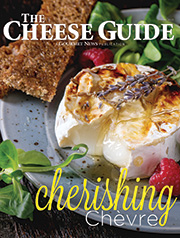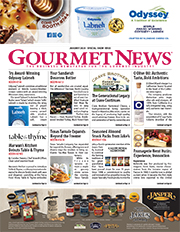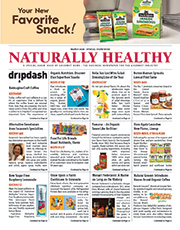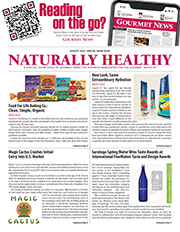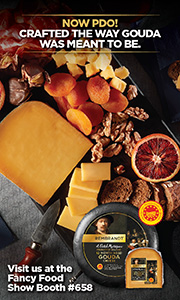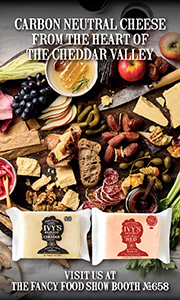
Special Diets
Bitchin’ Sauce Launches 30-Day Bowl Challenge
 If feeding your family and yourself feels like a juggling act most days, you’re not alone. But what if there was a way to simplify meals, feel more energized, and actually get excited about what’s on your plate? (Or in this case… your bowl!)
If feeding your family and yourself feels like a juggling act most days, you’re not alone. But what if there was a way to simplify meals, feel more energized, and actually get excited about what’s on your plate? (Or in this case… your bowl!)
Introducing the 30-Day Bowl Challenge, launching June 1st–led by Starr Edwards, the chef, creative force, and busy Bitchin’ Sauce CEO who somehow manages it all with a bowl in one hand and a little helper on the kitchen counter.
For 30 days straight, Starr will be whipping up and sharing one vibrant, delicious, and totally doable bowl a day–each one loaded with clean, whole foods and topped with her cult-favorite Bitchin’ Sauce. And she wants you to join her!
What is the Bowl Challenge?
It’s simple: one healthy bowl a day for the month of June. Think savory grain bowls, sweet breakfast bowls, colorful lunch bowls piled high with veggies–meals that are quick to build, fun to customize, and will leave you feeling awesome from the inside out.
Follow along on Instagram (@bitchinsauce) where Starr will post daily bowl inspo, weekly grocery lists, and helpful tips to make bowl-building a breeze–whether you’re cooking for one or feeding your whole crew.
“When I’m eating well, I sleep better, I focus better, and I feel more present in everything I do,” says Starr. “With five kids and a company to lead, I need healthy food that’s as energizing as it is easy. Bowls are my secret weapon!”
And with summer around the corner and the kids home more, mealtime can feel like an even bigger challenge. That’s why bowls are perfect: everyone picks what they love, builds their own combo, and tops it with Bitchin’ Sauce!
“It’s the one thing we all agree on,” Starr laughs. “From spicy Heat and smoky Chipotle to our lemony garlic Original, fresh Pesto, or the bold, warming spices of Bombay–there’s a sauce for everyone in the family!”
Why Join the Bowl Challenge?
It’s easy: just one bowl a day, made your way.
It’s healthy: filled with real, whole foods that keep you going.
It’s flexible: works for any meal of the day.
It’s energizing: a fun reset for you and your family.
The 30-Day Bowl Challenge isn’t about changing your whole routine–it’s just one good habit to add to your day. A simple, nourishing bowl made with love. And if you pair it with a glass of bubbly? Even better. Cheers to keeping it easy, tasty, and totally Bitchin’!
About Bitchin’ Sauce
Born from a mom’s heart and made famous at farmers markets across Southern California, Bitchin’ Sauce is the cult-favorite, almond-based dip that’s taking taste buds by storm. Plant-based, gluten-free, and endlessly versatile, Bitchin’ Sauce makes everything taste Bitchin’–from veggies and burgers to tacos, bowls, and beyond. Now available nationwide at retailers including Costco, Whole Foods, Target, and Kroger, you can find your favorite flavor in the refrigerated deli section or at www.bitchinsauce.com.
For more news of interest to the food and beverage industry, subscribe to Gourmet News.
Mezete Debuts Middle Eastern Food Products at IDDBA Show
 Global demand for authentic international cuisine is booming—and Middle Eastern food is leading the way. Mezete, a Jordan-based brand transforming traditional recipes into convenient, clean-label products, is excited to debut at the International Dairy Deli Bakery Association Show, June 1–3 in New Orleans.
Global demand for authentic international cuisine is booming—and Middle Eastern food is leading the way. Mezete, a Jordan-based brand transforming traditional recipes into convenient, clean-label products, is excited to debut at the International Dairy Deli Bakery Association Show, June 1–3 in New Orleans.
With a presence now in over 45 countries, Mezete’s U.S. expansion is fueled by growing consumer demand for bold, plant-based, preservative-free foods. At IDDBA, Mezete will showcase its full range of ready-to-eat dips, sauces, soups, and stews—all made with natural ingredients and no added oils.
“Middle Eastern cuisine is rich in flavor, culture, and nourishment,” said Khaled Kasih, CEO of KASIH Foods, Mezete’s parent company. “We’re proud to share authentic, ready-to-eat Middle Eastern foods crafted with care and integrity, just the way they’re made at home.”
We’re proud to share authentic, ready-to-eat Middle Eastern foods crafted with care and integrity, just the way they’re made at home.
What Makes Mezete Different?
- Mezete hummus is made with much higher levels of tahini vs U.S. made brands which provides a velvety smooth texture that you only experience when making it at home or in an authentic Middle Eastern restaurant.
- Clean-label, real food: All products are non-GMO Project Verified, vegan, halal, with many gluten-free options.
- No preservatives.
- No added oils: no cheap fillers or oils.
Not Just Hummus!
While known for its signature hummus, Mezete will present a wide variety of Middle Eastern staples, including:
Dips:
- Classic Hummus
- Red Hot Chili Hummus
- Zesty Za’atar Hummus
- Baba Ghanouj
- Muhammara
Sauces:
- Classic Tahini
- Shatta (spicy chili sauce)
- Toum (Garlic Sauce)
Soups & Stews:
- Adas Soup (Spiced Lentil Soup)
- Freekeh Soup (Smoked Wheat Kernel)
- Mulukhiyeh Stew (Vegan)
- Shakshouka Base Stew
Convenient single-serve hummus & dip cups paired with breadsticks, available in bold and exciting flavors.
- Classic Hummus with Breadsticks
- Roasted Red Pepper with Breadsticks
- Zesty Za’atar with Breadsticks
- Muhammara with Breadsticks
For more news of interest to the food and beverage industry, subscribe to Gourmet News.
Bobbie Unveils First USDA Organic Whole Milk Formula Made in USA
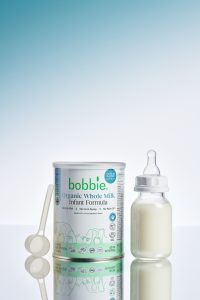 Bobbie has announced its fourth infant formula since the company’s launch in 2021: after three years of development, Bobbie Organic Whole Milk Infant Formula is here. As the first and only USDA Organic Whole Milk infant formula manufactured in America, this industry-first product redefines high quality infant nutrition. Developed with the leading science and research and manufactured at the brand’s state-of-the-art facility in the heartland of America, Heath, Ohio, Bobbie Organic Whole Milk infant formula offers quality, safety, and reliability at a time when the U.S. infant formula industry is facing continued uncertainty.
Bobbie has announced its fourth infant formula since the company’s launch in 2021: after three years of development, Bobbie Organic Whole Milk Infant Formula is here. As the first and only USDA Organic Whole Milk infant formula manufactured in America, this industry-first product redefines high quality infant nutrition. Developed with the leading science and research and manufactured at the brand’s state-of-the-art facility in the heartland of America, Heath, Ohio, Bobbie Organic Whole Milk infant formula offers quality, safety, and reliability at a time when the U.S. infant formula industry is facing continued uncertainty.
Only 7% of infant formulas sold in the U.S. are Organic and only 5% are certified USDA Organic. Just 4% of formulas sold in the U.S. use whole milk. Bobbie Organic Whole Milk Infant Formula is the ONLY routine infant formula manufactured in the U.S. that is both USDA Organic and made with whole milk.
Bobbie Organic Whole Milk infant formula is available today at hibobbie.com for $28/can and coming to select retailers this summer.
Since its launch four years ago, Bobbie remains dedicated to providing American families with high-quality, Organic infant formula made right here in the US. The research and development arm of the company, Bobbie Labs, spent three years developing Bobbie’s closest-to-breast milk recipe, featuring less vegetable oils, more naturally-occurring milk fat globule membrane (MFGM) from Organic whole milk, choline, and industry leading levels of DHA to support infant brain development. MFGM is a component of milk fat that has been linked to cognitive and immune system support in infants. MFGM is naturally found in breast milk, and research has suggested it can play a role in supporting brain development, immune health, and gut function.
“As a pediatrician, I am always looking for the best options to support infant nutrition, and I’m thrilled to see Bobbie Organic Whole Milk Infant Formula enter the market as the first and only USDA Organic whole milk-based formula manufactured in the U.S. Bobbie continues to set the standard for clean, high-quality infant nutrition by using naturally occurring milk fat globule membrane (MFGM) from whole milk—an essential component of breast milk that supports brain development. Bobbie continues to be a brand I trust and recommend for parents seeking a clean, high-quality, breast milk-inspired formula that prioritizes both safety and science-backed nutrition,” said Lauren Crosby, MD, FAAP.
Bobbie Organic Whole Milk formula undergoes over 2,000 safety and quality checks before release at Bobbie’s state-of-the-art manufacturing facility in Heath, Ohio. Owning end-to-end manufacturing has unlocked innovation on an entirely new level for the industry-disrupting, mom-led brand. With a steady supply of unlimited inventory, manufacturing redundancy, and the ability to produce high quality infant formulas in-house, Bobbie has unlocked the recipe development and manufacturing rigor required to lead the way for the next generation of American infant formula.
Bobbie Organic Whole Milk infant formula is the only USDA Organic whole milk infant formula on the US market, designed to bring parents a first-of-its-kind formulation that is certified Organic to both the USDA and EU Organic standards, and features a no palm oil, no soy fat blend. The groundbreaking recipe is made with USDA Organic whole milk, a critical choice in a formula category flooded with Organic claims that fall short of the USDA Organic seal.
“As a team of parents, we understand first hand the importance of quality and reliability when it comes to feeding our babies. No parent should have to choose between the two and with this product, we can guarantee the best of the best on both fronts,” saidLaura Modi, CEO and Co-Founder of Bobbie and mom of four.“This recipe, the first USDA Organic whole milk infant formula in the world, is the epitome of my why behind Bobbie. It’s a dream formulation that represents much more than what’s inside the can (though I’m very proud of that as well) – it is about pushing the nutritional standards forward, reimagining how we feed babies in the U.S., and making America the gold standard in infant nutrition.”
Bobbie Organic Whole Milk Formula Overview:
- Premium USDA Organic Standards: The first certified USDA Organic whole milk infant formula manufactured in America – certified to meet the strictest Organic standards in the world. Made with no synthetic pesticides, chemical contaminants, glyphosates, or GMOs.
- Our Closest-to-Breast Milk Recipe – For Smoother Poops: Whole milk fat and fewer added oils means it’s a recipe that closely mimics breast milk and may support softer stools. Less straining means a happier baby – and happier parents.
- Premium Brain Support: Featuring the ultimate triple threat – naturally occurring milk fat globule membrane (MFGM) from whole milk, choline, and industry-leading levels of DHA. MFGM supports cognitive development and gives tiny brains a major boost – a smart choice, literally.
- Premium Milk Fat; Less Added Oil: The naturally-occurring fat in whole milk provides fatty acids like those found in breast milk. This means less plant-based oils. And never soy or palm oil.
- Available Today: Buy Organic Whole Milk infant formula today at hibobbie.com. 14oz cans retail for $28. Find us at select retailers early Summer.
About Bobbie:
Bobbie is the purpose-driven organic infant feeding company that exists to build a parenting culture of confidence, not comparison. Founded in 2018, Bobbie hit the market with its flagship European-inspired formula in 2021 as the first direct-to-consumer, subscription-based infant formula in the U.S. Today, it’s proud to be the only mom-founded and led infant formula brand in the world, and the fastest-growing in the U.S. since the 1980s. Bobbie is focused on providing purposefully sourced, USDA Organic products made with simple ingredients – crafted right here in America, for American families. For more information, visit www.hibobbie.com.
For more news of interest to the food and beverage industry, subscribe to Gourmet News.
